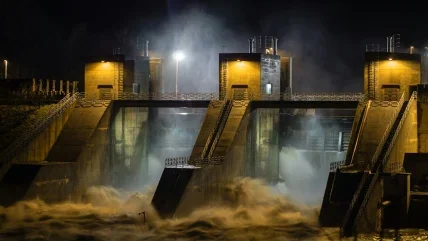
South Georgia in the South Atlantic Ocean has a history of hydropower dating as far back as 1914. Home of the Applied Fisheries Research Station, staffed by scientists from the British Antarctic Survey and the Museum of South Georgia, it is also the site of Antarctic explorer Ernest Shackleton’s grave.
Covering a total area of around 3900km2, South Georgia and the South Sandwich Islands are classed as sub-Antarctic. Rising steeply from the sea, they are rugged and glacier-covered mountains.
South Georgia was originally a whaling base, and the main station was at Grytviken on the northeast side of the island. The station was powered by hydropower up until the time it fell into disuse in the 1960s. Much of the infrastructure including Gull Lake Dam remained in place and in 2007 Morrison International was commissioned to undertake some refurbishment and rebuilding work. In discussions with Gilbert Gilkes & Gordon of Kendal in England, the decision was taken to install a new hydroelectric generation system, using much of the existing infrastructure.
A 13.5” Twinjet Turgo Impulse (a turbine originally designed and patented by Gilkes) was installed in 2008, providing 250kW of power to Grytviken and the British Antarctic Survey Base at King Edward Point.
Second Installation
As the island’s power usage trends have steadily increased, along with the desire to reduce reliance on diesel as backup generation, it meant there was now significant requirement for additional hydroelectric generation on the island.
Following flow and pressure measurements carried out by Paul Cousens of the British Antarctic Survey, Gilkes advised on the options and feasibility of a second micro hydroelectric turbine located at Grytviken. The machine would be installed on the recently refurbished domestic water supply pipe from the Bore Valley intake feeding King Edward Point and Grytviken. An essential consideration was that the water supply pressure must be kept above 3 bar.
Gilkes considered various options and advised on a 7.5” Turgo with a mechanical output of 13kW. These machines are from Gilkes’ Compact range and were ideally suited due to their simplicity and ability to maintain efficiency across the varying hydrology (both head and flow). The machine’s compact footprint, high speed and robust construction also make it an ideal match for the site’s requirements.
The new machine will be installed in late 2023 with commissioning scheduled for January 2024. It will be skid mounted so that assembly, cabling, and alignment can be completed in Gilkes’ factory. This has the added benefit of reducing the timescales for onsite installation and commissioning.
In terms of operation the main hydro minimum load is always above 15kW, so the new machine will be connected in parallel to the local network feeding the existing hydro that provides power as baseload. This will result in reduced energy waste, control system requirements, monitoring of the equipment and reduced start/stop events for the new system.
South Georgia plays host to over 5000 visitors a year and has become one of the world’s most exclusive destinations for environmental tourists, as well as being home to an extraordinary amount of wildlife, including seven million penguins. Both hydro installations on the island have been designed with the environmentally sensitive area and local wildlife in mind. The main power station is very quiet; the main sound being the water in the tailrace in the bottom of the building as it makes its way to the sea.
Power demand at King Edward Point and Grytviken now runs almost entirely on the existing hydro. Diesel generating sets are for emergency back up only and to cycle the fuel storage. The use of diesel is not the most eco‐friendly solution and has the added problems of ongoing cost, safe transportation, and storage, hence the installation of a second micro hydro to ensure the future of renewable energy on the island.
Gilkes will also supply annual technician training to the British Antarctic Survey to enable them to run and maintain the equipment.
Turbine selection
Turgo Impulse turbines were selected for both hydro installations at Grytviken. The Turgo is ideally suited to this application as it maintains efficiency over a large flow range and is of a proven and rugged design.
The standard range of Turgo turbines that Gilkes manufacture range from 7.5” – 43”, so the machine at Grytviken will be by far the smallest in terms of output in recent years. Although equally happy here, these Compact 7.5” machines normally operate under greater heads and flow rates and are usually configured in the 30kW to 100kW range. The flexibility of the Turgo runner results in a machine that is suitable for an extremely varied operating envelope.
Gilkes conventional range of Turgo turbines which are more commonly found in the 500kW to 5MW range provide a specialised and cost-effective solution where there is a combination of medium head, varying flow rates and the requirement for a compact package with minimal operational and maintenance requirements.
Stats Turbine 1
Customer: Morrison Construction
Head: 65m
Flow: 472 l/s
Turbine type: Gilkes Twin Jet Turgo
Output power: 250 kW
Dia: 13.5”
Speed: 1000 rpm
Commissioned: 2007
SCOPE OF SUPPLY
Gilkes 13.5” Twin Jet Turgo Turbine
Hydraulic Control Module
Main Inlet Valve with actuator
Electrohydraulic Governor System
Synchronous Generator with Flywheel
Control Panel
Head level sensor
Installation & Commissioning
Stats Turbine 2
Customer: Government of South Georgia and the Sandwich Islands
Head: 61m with significant head losses due to use of existing pipework
Flow: 42 l/s
Turbine type: Gilkes Single Jet Compact Turgo
Output power: 13 kW
Dia: 7.5”
Speed: 1,500 rpm
Commissioned: planned in 2023, depends on site work completion
SCOPE OF SUPPLY
Initial Feasibility and Technical Support
Pipework upstream of Main inlet Valve
Main Inlet Valve with actuator
Gilkes 7.5” Single Jet Compact Turgo
Electronic Governing System
Induction Generator
Skid Mounting
Control Panel
Base Station Transmitter
Local Control and Power cables
Head level Sensor and Cabinet
Installation & Commissioning






